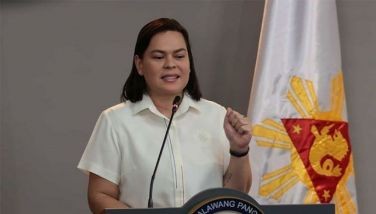Goodbye inflation?

The inflation boogeyman seems to have been beaten – knocked out and black and blue, just like in boxing.
Indeed, the great inflation monster of the post-pandemic period appears to have been driven away.
The US was the first to call this when in mid-September, it cut interest rates by half a percentage point, saying that inflation was no longer a problem.
It’s the same here at home, especially with Friday’s surprise inflation, a jaw-dropping 1.9 percent in September – the lowest since May 2020. Our economic managers must be popping the champagne, celebrating what seems to be the end of the stubborn inflation era.
In reality though, it’s not quite party time just yet.
Prices are still high
Just go to your favorite supermarkets and neighborhood sari-sari stores and you will see that prices remain high and Filipinos are still feeling the pinch.
Why is this? Because the fact remains that prices are still up. A low inflation in September does not mean that prices are down. It just means the rate of the increase in prices of basic goods and commodities is slower.
If you make that grocery run, you will see that prices are still absurd.
Some examples:
A carton of milk costs P120, from P90 in the recent past; a can of sardines now costs P30 from P19 before, while galunggong has gone up to P211 from P197.
Did you know that even our all-time favorite coconut is now at P40 to P45 per piece from P30 to P35 before?
What does this mean for Filipinos?
It means that while inflation may no longer be an economic problem, it is still very much a gut issue. It means prices are relatively stable compared to before but the fact remains that the cost of living in this country of 120 million is still high and for some 20 million Filipinos living below the poverty line, it is still a major struggle to put food on the table.
This is what the Marcos administration needs to keep in mind.
The main driver of low inflation is slower inflation in food and non-alcoholic beverages, which registered a slower increase of 1.4 percent in September from 3.9 percent in August. Inflation for rice was at 5.7 percent in September from 14.7 percent in the previous month.
But the slower rice inflation is due to the base effects, meaning because of high inflation in the previous years and not so much – or not yet – because of President Marcos’ Executive Order 62, issued in July, which reduced rice tariffs to 15 percent from 35 percent.
Rice at P20 per kilo?
Speaking of rice, we have yet to see Marcos’ campaign promise of a P20-per-kilo-rice become a reality.
The lower tariffs on rice are expected to lower rice prices but it’s taking time. Rice prices range from P45 to P48 per kilo at present for the regular-milled rice.
Certain quarters in the agriculture industry have voiced their growing frustration that the government’s promise of retail rice price reduction is not yet materializing two months after the tariff cut took effect.
Several factors may be blamed for this. One, Vietnam and Thailand seem to have taken advantage of India’s self-imposed export ban on rice by raising their prices, knowing too well that we had no choice but to import from them with India out of the equation.
It was only recently that India lifted its export ban amid strong global demand.
Importers may have also been just pocketing the tariff savings for themselves by continuing to sell their supply at high prices.
The government said that because of the lower tariffs, the landed cost of the imported rice has declined by 15 percent or around P7 per kilo as of mid-September.
We have yet to see the full impact of this.
As Agriculture Secretary Francisco Tiu Laurel said, January 2025 would be the real test of the rice tariff cut or once a significant volume of new imports have entered the market and demand has stabilized.
Elections and the cost of living
Thus, while government interventions including the Bangko Sentral’s monetary balancing acts are welcome, long-term solutions to lower the cost of living in the country are still very much needed.
The kind of politicians that Filipinos will vote for in the 2025 elections can spell the difference between seeing a better Philippines or the same banana republic.
Long-term solutions to lower the cost of living include improving food supply and lowering transport costs by, for example, building farm-to-market roads.
But we lack roads and other infrastructure because taxpayers’ money supposedly for these projects end up in the pockets of politicians.
Baguio City Mayor Benjamin Magalong did research on the rackets of politicos and he found out that these unscrupulous individuals take 70 percent in kickbacks from road projects.
Corruption has a ripple effect. Because of the billions that are pocketed by crooks, the government has no choice but to source the revenue elsewhere, including from VAT and other taxes, which in turn jack up the cost of goods and services that we consume.
According to PIDS, an estimated P1.4 trillion has been lost to corruption in 2017 (P670 billion) and 2018 (P752 billion) and that around 20 percent of the annual government appropriation goes to corruption.
Appalling isn’t it?
But what would be more appalling is if we elect the same old trapos back in power come May 2025.
* * *
Email: [email protected]. Follow her on Twitter @eyesgonzales. Column archives at EyesWideOpen on FB.
- Latest
- Trending




























